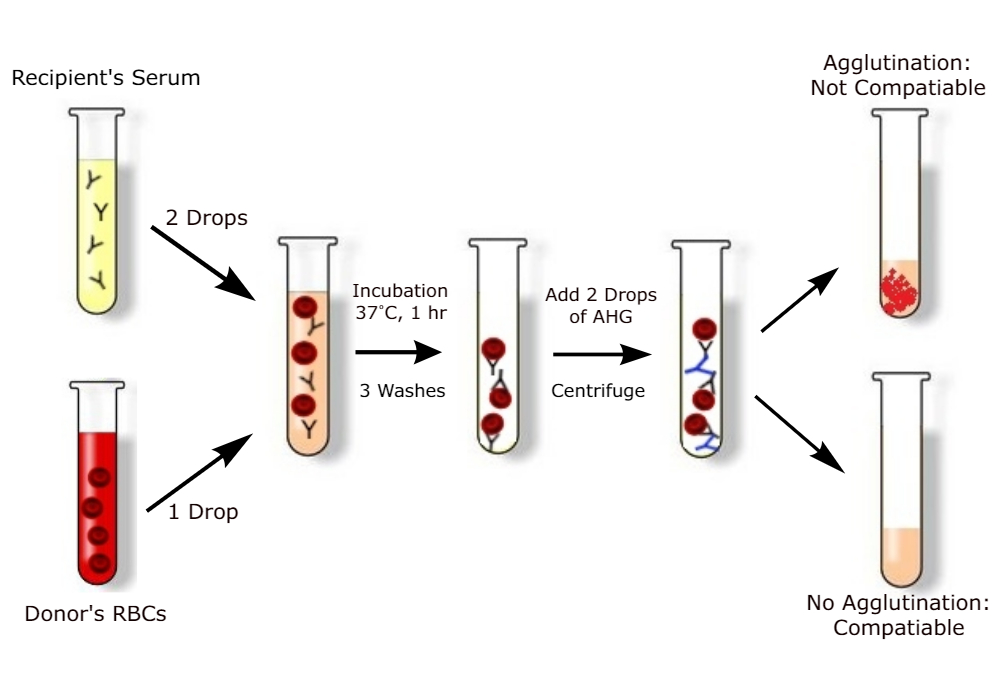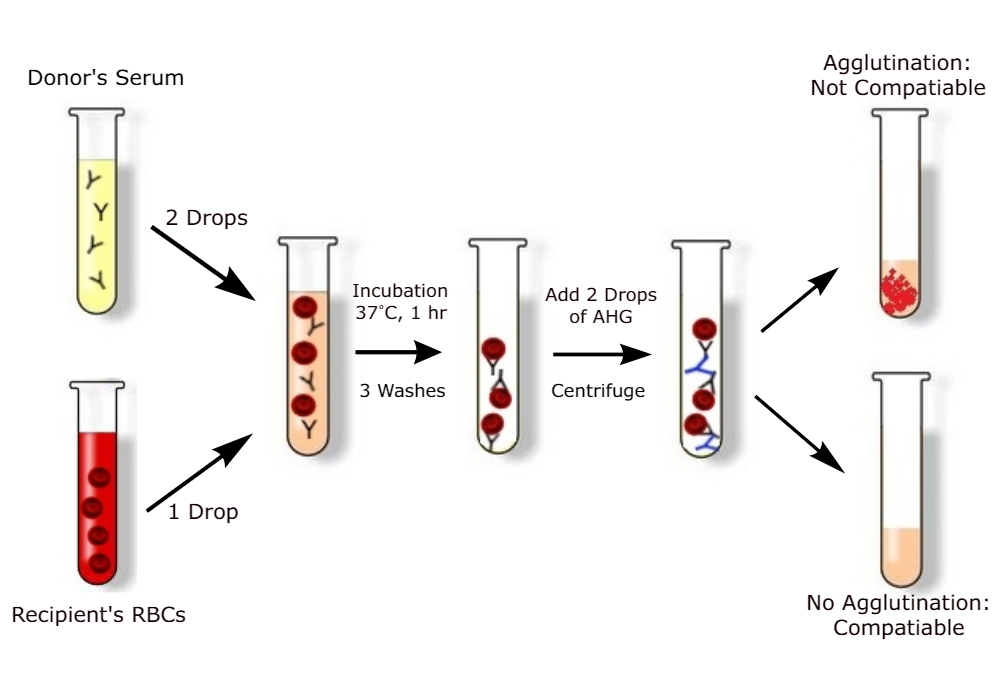- Most recipient antibodies directed against donor’s red blood cell antigens.
- Most donor antibodies directed against recipient’s red blood cell antigens.
- Major errors in ABO grouping, labeling and identification of donor and recipients.
Principle of Cross Matching
Cross matching is based on the principle of serological detection of any clinically significant irregular/unexpected antibodies in either donor or recipient’s blood. There are two types of cross matches:
- Major Cross Match: It involves testing the donor’s red cells with recipient’s serum to determine the presence of any antibody which may cause hemolysis or agglutination of donor red cells.This is more important than minor cross match.
- Minor Cross Match: It involves testing of donor’s plasma with recipient’s red cells to determine the presence of any antibody which may cause hemolysis or agglutination of recipient’s red cells.
| Type | Donor’s | Recipient’s |
|---|---|---|
| Major Cross Match | Red Cells | Serum/Plasma |
| Minor Cross Match | Serum/Plasma | Red Cells |
Procedure of Cross Matching
There are different methods for cross matching, as shown in table. Among them most commonly used technique is Anti-human globulin (AHG) cross match.
| Method of Cross Match | Detects Antibody of Type : |
|---|---|
| Saline Cross Match | IgM |
| Albumin Cross Match | IgG |
| Anti-Human Globulin (AHG) Cross Match | IgG |
Major Cross Match
- Prepare donor and recipient’s blood sample: Donor’s red cells and recipient’s serum/plasma.
- Prepare 3-5% saline cell suspension of red cells.
- Label a test tube.
- Add two drops of recipient’s serum and one drop of donor cell suspension.
- Mix and incubate the tubes at 37 degree Celsius for about 60 minutes.
- Decant the serum completely and wash the cells three times in saline.
- Add two drops of Anti-human Globulin (AHG) and mix. Allow to stand at room temperature for 5 minutes.
- Centrifuge at 1500 rpm for 1 minute.
- Observe macroscopically and microscopically for agglutination.
- If macroscopic agglutination is not observed, transfer a small amount onto a glass slide and examine for microscopic agglutination. Rouleaux is not an indication of incompatibility.

Minor Cross Match
- Prepare donor and recipient’s blood sample: Recipient’s red cells and donor’s serum/plasma.
- Label a test tube.
- Add two drops of donor’s serum and one drop of recipient’s cell suspension.
- Mix and incubate the tubes at 37 degree Celsius for about 60 minutes.
- Decant the serum completely and wash the cells three times in saline.
- Add two drops of Anti-human Globulin (AHG) and mix. Allow to stand at room temperature for 5 minutes.
- Centrifuge at 1500 rpm for 1 minute.
- Observe macroscopically and microscopically for agglutination.
- If macroscopic agglutination is not observed, transfer a small amount onto a glass slide and examine for microscopic agglutination. Rouleaux is not an indication of incompatibility.

Results and Interpretation
Compatible donor and recipient blood should show no agglutination in both major and minor cross match. Blood which shows incompatibility in major cross match should never be transfused, because the large plasma volume of the recipient blood containing antibodies can destroy the donor’s red cells easily. The minor incompatibility is less important because the donor’s serum which contains the antibodies is diluted in the recipient’s own plasma, making the antibodies very dilute and ineffective.

Thanks.
Thankyou so much sir
Why is it that after incubation of anti-human globulin for 60 minutes in a water-bath anti-human globulin reagent is added again?
1. to wash away antibody (globulin) that not grab on the red blood cells’ surface. you want to wash away the free antibody (globulin.
2. bath again with the antihuman globulin because: if there is any antibody (globulin) that have grabed on the red blood cells will show a agglutination reaction by this antihuman globulin you added.
absolutely not a agglutination reaction between the free antibody (globulin) and antihuman globulin you added.
GOOD EXPLANATION AND ILLUSTRATIONS HERE. THANK YOU.
Thanks 😊
thanks good sir